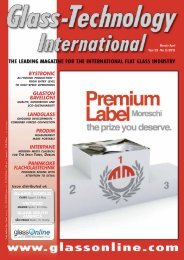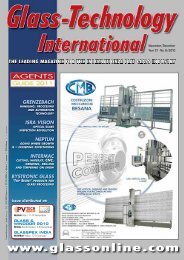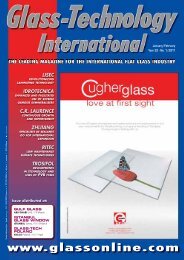VITRUM ENERGIA - Artenergy Publishing
VITRUM ENERGIA - Artenergy Publishing
VITRUM ENERGIA - Artenergy Publishing
Create successful ePaper yourself
Turn your PDF publications into a flip-book with our unique Google optimized e-Paper software.
26<br />
business news<br />
PILKINGTON<br />
Australian automotive glass plant reopens<br />
Australia’s only automotive glass manufacturing<br />
facility in Geelong, the former Pilkington<br />
plant, has been reopened. According to industry minister<br />
Senator Kim Carr, the reopening of the plant demonstrates<br />
the power of partnerships between industry and<br />
government.<br />
“This reopening is not just great news for the working<br />
families of Geelong, but for our resilient and innovative<br />
automotive industry,” Senator Carr said.<br />
“Not only have 68 automotive jobs and critical industrial<br />
capacity been preserved, but we have even succeeded<br />
in securing new investment.”<br />
“This is a credit to all concerned, and especially to the<br />
new owners, MHG. The company has demonstrated great<br />
courage and vision in the hardest of economic times.”<br />
“The reopening has been assisted by AUD 4.5 million<br />
from the Automotive Industry Structural<br />
Adjustment Program, part of the Rudd Government’s<br />
New Car Plan for a Greener Future.”<br />
“The announcement comes at a time when automotive<br />
manufacturers worldwide are seeking to trim their<br />
balance sheets in the aftermath of the worst global recession<br />
in a generation.”<br />
“MHG’s acquisition of the Geelong plant is an<br />
important example of the supply chain consolidation we<br />
need, and a great gesture of faith in Australia’s automotive<br />
future.”<br />
“Rationalization is never easy, but it is absolutely<br />
essential if the supply chain is to keep winning business<br />
locally and internationally.”<br />
“We have made it work in glass manufacturing, and<br />
we can make it work in other areas as well.”<br />
GHAZVIN GLASS<br />
float production starts up<br />
Iran’s leading glassmaker GGC (Ghazvin<br />
Glass Co.), has announced that its new plant,<br />
located 200 km west of Tehran in a 50-hectare area,<br />
became operational in December 2009.<br />
The plant uses Pilkington technology and supervision,<br />
and will have an annual capacity of 180,000 tons<br />
of 1.8-19mm thick glass.<br />
Once fully operational, the plant will enable GGC to<br />
export mirror and automotive quality float glass to the<br />
neighbouring region.<br />
Glass-Technology International 2/2010<br />
w w w . g l a s s o n l i n e . c o m<br />
“This announcement also demonstrates the close<br />
working relationship between Federal and Victorian<br />
Governments, and their role in minimizing the impact<br />
of the financial crisis on business and families.”<br />
“The Rudd Government will continue to work in<br />
partnership to transform automotive manufacturing and<br />
support high-wage, high skill jobs in Geelong and<br />
across the country,” Carr said.<br />
Collaboration with Dyesol<br />
Ohio-based Pilkington North America has announced<br />
that it will start collaboration with Dyesol Inc. for the<br />
development of opportunities in the building integrated<br />
photovoltaics (BIPV) marketplace utilizing Pilkington’s<br />
TEC series of transparent conductive oxide (TCO) coated<br />
float glass and Dyesol’s dye solar cell (DSC) materials<br />
and technology.<br />
“Pilkington believes it is time to begin developing the<br />
next generation of photovoltaic power,” says Stephen<br />
Weidner, senior vice president of building products for<br />
North America. “BIPV is an emerging market segment<br />
with great opportunity for utilizing our TCO technology<br />
to bring photovoltaic power into building design.”<br />
“The collaboration with Dyesol has the potential to<br />
bring a significant change in the value of architectural<br />
glass as we know it today. No longer will glass be viewed<br />
solely for its insulation and aesthetic properties, but for<br />
its power generating potential as well,” Weidner adds.<br />
“Pilkington is the world leader in the production of<br />
TCO glass. In fact, Dyesol and their customers have<br />
been utilizing Pilkington’s TEC product for many<br />
years. This collaboration presents an ideal platform for<br />
co-developing and optimizing products that work<br />
together to improve DSC performance,” says Marc M.<br />
Thomas, chief executive officer of Dyesol Inc. “With<br />
25% of all electrical energy consumed in the US used<br />
in the built environment, the market opportunity is<br />
enormous.”<br />
Dr. Gavin Tulloch, the global managing director,<br />
chief technology officer and co-founder of Dyesol Ltd.,<br />
comments, “DSC technology can best be described as<br />
‘artificial photosynthesis’ using an electrolyte, a layer of<br />
titania (a pigment used in white paints and toothpaste)<br />
and ruthenium dye deposited on transparent conductive<br />
oxide glass, metal or polymer substrates. Light striking<br />
the dye excites electrons which are absorbed by the titania<br />
to become an electric current many times stronger<br />
than that found in natural photosynthesis in plants.<br />
Dyesol’s technology has lower cost and embodied energy<br />
in manufacture, produces electricity more efficiently<br />
even in low light conditions and can be directly incorporated<br />
into buildings by replacing conventional glass.”







